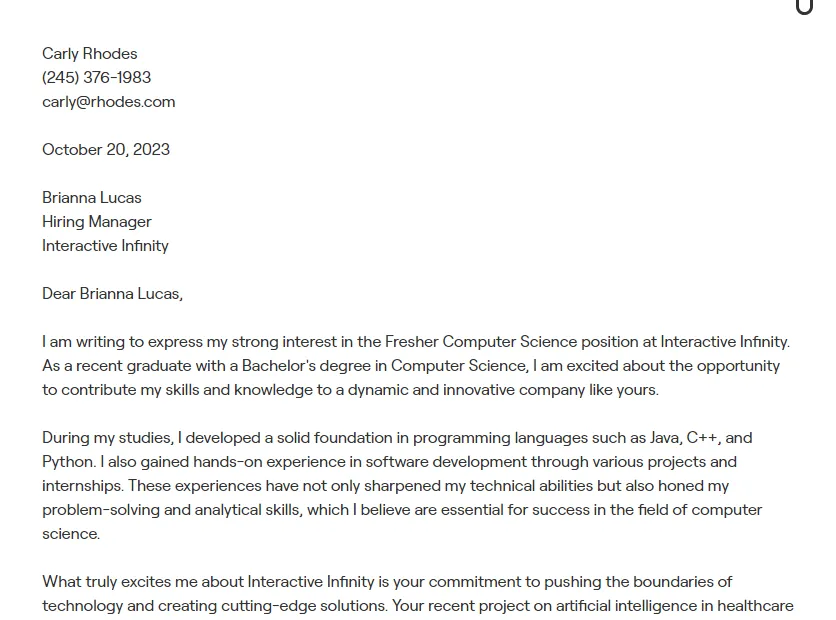Understanding the Importance of a Cover Letter
In the competitive landscape of computer science, a compelling cover letter is far more than just a formality – it’s your personal marketing document and your first opportunity to make a lasting impression. While your resume provides a factual overview of your skills and experience, the cover letter allows you to tell your story, demonstrate your personality, and articulate your genuine enthusiasm for the specific role and the company. It is where you showcase why you are the ideal candidate. It reveals your communication skills, your understanding of the company’s needs, and your genuine passion for the field. A well-crafted cover letter can significantly increase your chances of securing an interview and making a positive impact. In the fast-paced world of computer science, where numerous qualified candidates are vying for the same positions, a cover letter offers the crucial edge needed to stand out and capture the hiring manager’s attention. Without a strong cover letter, your application may be overlooked. In summary, it is an essential element of your job application.
Highlighting Your Skills and Experience
When composing your cover letter, the most important aspect is to effectively highlight the skills and experiences that are most relevant to the job description. Start by carefully reviewing the job posting, identifying the key requirements, and the desired qualifications. Then, tailor your letter to directly address these requirements, providing specific evidence to demonstrate your capabilities. Do not just list your skills, but provide compelling examples of how you have utilized them to achieve significant results. For example, instead of saying, “Experienced in Python,” you could write, “Developed and deployed a Python-based data analysis pipeline that improved processing efficiency by 45%.” Quantify your achievements whenever possible to showcase the impact of your work. Use strong action verbs to describe your accomplishments and avoid vague or generic statements. Focus on the skills and experiences that directly align with the job, such as expertise in software development, data analysis, cloud computing, cybersecurity, or artificial intelligence. Clearly describe in detail the results of your efforts on previous projects and the technologies you have mastered.
Tailoring Your Cover Letter for Computer Science

A generic, one-size-fits-all cover letter will not make a significant impression on hiring managers in the specialized field of computer science. To truly stand out, you must tailor your cover letter to each specific role and the company you are applying to. This is essential for demonstrating that you have taken the time to research the organization and understand its needs. Research the company extensively, learning about its mission, values, current projects, and recent achievements. Show that you truly understand their business and how your specific skills can contribute to their success. In your letter, make sure to reference specific technologies, projects, or challenges that directly align with the company’s current work. Explain how your skills and experience specifically address their needs. Demonstrate your understanding of the company’s industry position, market, and competitors, if any. Show that you have done your homework by highlighting recent achievements or initiatives. Show that you understand the company’s culture. A customized cover letter reflects your initiative, attention to detail, and genuine enthusiasm, all of which are highly valued qualities in the computer science industry.
Key Components of a Computer Science Cover Letter
A well-structured computer science cover letter contains several key components that work together to make a strong impact: a compelling opening, a clear explanation of your skills and experience, a demonstration of your interest in the company, and a strong closing. Begin with an opening that immediately grabs the reader’s attention and clearly states the specific position you’re applying for and how you learned about the opportunity. In the body of your letter, clearly highlight your relevant skills and experience, providing specific examples to showcase your accomplishments. Explain why you are genuinely interested in the company, referencing their work, mission, or recent achievements. Clearly articulate your understanding of their work and your enthusiasm for the specific opportunities that align with your career goals. In your closing, reiterate your enthusiasm for the position and express your eagerness to learn more. Include a clear call to action, such as requesting an interview. A well-organized and concise cover letter reflects your professionalism, attention to detail, and strong communication skills. Remember to keep your language clear, concise, and free of unnecessary jargon that might confuse the hiring manager. A well-structured cover letter is crucial for a successful application.
Formatting Your Cover Letter
The formatting of your cover letter is essential for making a positive first impression and presenting yourself as a professional candidate. Use a professional, easy-to-read font, such as Times New Roman, Arial, or Calibri, with a font size between 10 and 12 points. Maintain consistent formatting throughout the document, including margins (typically 1 inch on all sides), line spacing (single or 1.15), and headings. Ensure that the letter is well-spaced and easy on the eyes. Break up long blocks of text with paragraphs and bullet points to improve readability. A well-formatted cover letter demonstrates attention to detail. Ensure your cover letter is free of grammatical errors and typos by thoroughly proofreading and editing your work. Include your contact information at the top of the letter, including your name, phone number, email address, and a link to your LinkedIn profile or online portfolio. The overall layout should be clean, professional, and easy to follow. The format should reflect a professional impression.
Demonstrating Your Passion for Computer Science

Hiring managers in the computer science field actively seek candidates who exhibit a genuine passion for the subject matter. Show your enthusiasm by clearly articulating your specific interests within the field and explaining why you’re drawn to the role and the company. Mention any personal projects, open-source contributions, or professional development activities that demonstrate your continuous commitment to learning and growth. Highlight any relevant extracurricular activities, such as participation in hackathons, coding clubs, or online forums, which showcase your active engagement in the broader tech community. Showcase your sincere interest by highlighting the specific aspects of the role and the company that truly resonate with you. Articulate your understanding of the company’s work and explain why you are genuinely excited to contribute to their goals. Your passion should be clear through your word choices, your tone, and the specific details you include in your letter, proving that you are motivated to excel in computer science. Make sure to showcase your enthusiasm for the future of computer science and your desire to make a significant contribution to the field.
Showcasing Relevant Projects and Achievements
Providing concrete evidence of your skills and achievements is essential for making a strong and lasting impression. Detail specific projects you’ve worked on, detailing your role, the technologies you utilized, and the results you achieved. Quantify your achievements whenever possible; for example, instead of writing, “Improved website performance,” state, “Optimized website code, resulting in a 40% reduction in page load time and a 25% increase in user engagement.” If you have a portfolio or a GitHub profile, be sure to include a link in your cover letter, allowing the hiring manager to quickly review your work. Describe any challenges you faced during your projects and how you overcame them. This demonstrates your problem-solving skills and your ability to learn from experience. Tailor your project descriptions to directly align with the job requirements. Focus on the skills and technologies most relevant to the role. Consider providing links to live demos or code repositories of your projects. Highlighting your projects and achievements provides tangible evidence of your capabilities and demonstrates your potential to contribute to the company’s success. Showcasing concrete accomplishments can make the difference between getting the job or getting passed over.
Proofreading and Editing Your Cover Letter
Before submitting your cover letter, it’s critical to meticulously proofread and edit it to ensure that it is completely free of any errors. Mistakes in grammar, spelling, and punctuation can significantly undermine your credibility. Utilize a grammar checker and spell checker to initially identify any potential errors; however, do not rely on these tools alone. Proofread your letter multiple times, reading it slowly and carefully. Read your cover letter aloud to catch any awkward phrasing or inconsistencies. Ask a trusted friend, mentor, or career counselor to review your letter and provide feedback. Often, they can identify errors or areas for improvement you may have missed. Pay close attention to the overall tone and style of your letter, ensuring that it is professional, clear, and concise. Verify that your cover letter is well-structured and that the content flows logically. Proper proofreading and editing are essential to ensure that your cover letter presents you in the best possible light, significantly increasing your chances of securing an interview and ultimately getting hired. A polished cover letter is a direct reflection of your professionalism and attention to detail, leaving a positive and lasting impression.
